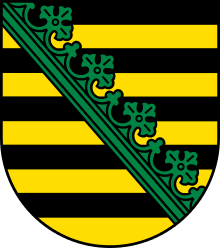Martin Mutschmann
| Martin Mutschmann | |
|---|---|
| Gauleiter of Saxony | |
|
In office 1925–1945 | |
| Preceded by | None |
| Succeeded by | None |
| Reichsstatthalter of Saxony | |
|
In office 1933–1945 | |
| Prime Minister | Manfred Freiherr von Killinger, Himself |
| Preceded by | None |
| Succeeded by | None |
| Minister-President of Saxony | |
|
In office 1935–1945 | |
| Preceded by | Manfred Freiherr von Killinger |
| Succeeded by | Rudolf Friedrichs |
| Personal details | |
| Born |
March 9, 1879 Hirschberg, Principality of Reuss-Gera, German Empire |
| Died |
February 14, 1947 (aged 67) Moscow, USSR |
| Political party | National Socialist German Workers' Party (NSDAP) |
Martin Mutschmann (9 March 1879 – 14 February 1947) was the Nazi Regional Leader (Gauleiter) of the state of Saxony (Gau Saxony) during the time of the Third Reich.
Biography
Born in Hirschberg on the Saale in the Principality of Reuss-Gera, Germany, Mutschmann moved while he was young with his family to Plauen in Saxony. He served an apprenticeship as an embroiderer and from 1896 to 1901 was employed as a master embroiderer, department head and warehouse director in lace and linen factories in Plauen, Herford and Köln.[1] This was followed by military service from 1901-1903, after which he returned to employment in the Plauen Lace Factyory (Plauener Spitzenfabriken).[1] He established his own lace factory, Mutschmann & Eisentraut, in Plauen in October 1907.[1] During World War I, he served on the Western Front until he was severely wounded in April 1916. He was discharged from the Army as unfit for field service on 24 December 1916, then resuming the direction of his factory in Plauen.[1] After the war, he was an early participant in the nationalist and anti-semitic Deutschvölkischer Schutz und Trutzbund. He was a founding member of the local branch (Ortsgruppe) of the National Socialist German Workers Party (NSDAP) in Plauen and made personal donations of capital to the Nazi Party.
Mutschmann lost his lace business in the Great Depression. But he continued to solicit donations from other businesses. His fundraising skills found favour with the Nazi Party.
Mutschmann was nominated Gauleiter of Saxony in 1925. He maintained this position until the end of World War II. Generally his political activity concentrated on Saxony rather than on Germany as a whole. Mutschmann was passionately interested in the preservation of Saxon arts and crafts.
On 30 January 1933, after the Nazis came to power, Mutschmann was appointed Nazi Governor (Reichsstatthalter) of Saxony. A passionate hunter, He was the Gau-jägermeister (Hunting Master) of Saxony.[2] He was often accused of being more interested in his hobby than the welfare of Saxony. The bombing of Dresden gave no exception to such accusations. Mutschmann has been blamed for not preparing that city for the horrific bombing, which occurred from 13 February to 15 February 1945.
On 1 May 1945, Mutschmann was in Dresden. As the Gauleiter of Saxony, he insisted that the city go into public mourning after the suicide of German dictator Adolf Hitler on 30 April 1945. On 5 May, Mutschmann let it be known that a large-scale German offensive on the Eastern Front was about to be launched. Two days later, on 7 May, Mutschmann was captured by Soviet troops while trying to escape.[3]
Mutschmann was sentenced to death in Moscow and shot on February 14, 1947.[4]
Awards and decorations
- 1914 Iron Cross 2nd Class[5]
- 1918 Wound Badge in Black, c.1918[5]
- 1922 Coburg Badge, October 1932[5]
- Golden Party Badge, 1933[5]
- Anschluss Medal, c.1938[5]
- Sudetenland Medal, c.1939[5]
- Honour Chevron for the Old Guard[5]
- SA Sports Badge[5]
Notes
- 1 2 3 4 Miller 2017, p. 327.
- ↑ Miller 2017, p. 333.
- ↑ Page 228, "The Decline and Fall of Nazi Germany and Imperial Japan", Hans Dollinger, Library of Congress Catalogue Card Number 67-27047
- ↑ Ernst Klee, Das Personenlexikon zum Dritten Reich, Frankfurt 2003. ( Biographies of persons of the Third Reich).
- 1 2 3 4 5 6 7 8 Miller 2017, p. 341.
References
- Miller, Michael (2017). Gauleiter Volume 2. California: R James Bender Publishing. ISBN 1-932970-32-0.
See also
- German presidential election, 1925
- German presidential election, 1932
- Machtergreifung - "Seizure of Power" - 30 January 1933
- Bombing of Dresden in World War II
- List of Gauleiters
- Ehrenburger Johanngeorgenstadt
